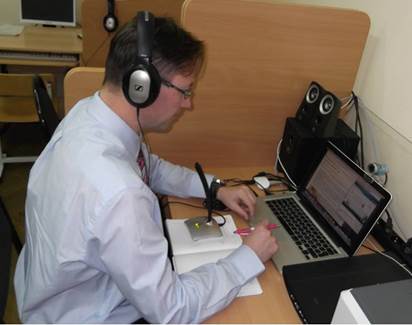Since English has been the dominant language in the academic world for many decades, second language learners need to develop their academic communication skills, especially academic writing. To enhance academic writing skills in tertiary education, academic writing centers have been established in Russian universities since the 2010s. However, there are some differences in their services or target audience [1]. The Center for Academic Writing «Impulse» (CAWI) was created at the University of Tyumen in 2016. The main mission of the Center is to provide scaffolding for university scholars who are planning to publish their research in high-impact journals in English. To accomplish this mission, the Center offers workshops and courses on various research writing issues, as well as consultations on research papers. Each time, the practice of CAWI is strengthened by modifying its activities or creating new ones. For example, during the first year, the Center’s workshops, courses, and consultations were adapted to a reading-to-writing approach [2]; subsequently, specific activities were designed to help researchers overcome the problem of writer’s block [3]. We try to keep abreast of our researchers’ writing strategies and to anticipate the problems they might encounter in the process. The latest strategy of research writers is to use machine translators, and the challenge is to apply them properly and efficiently. This article aims to describe a course for university research writers based on working with machine translators.
Rationale for the Course
In our seven years of delivering courses, workshops, and consultations at CAWI, we have been striving to develop strategies for facilitating the process of acquiring academic writing skills, so that scholars can achieve their goals quickly and efficiently. These strategies have emerged from the problems observed during the Center’s events or mentioned in participants’ feedback. Prior to launching a new academic writing course in October 2023, we identified the following three concerns to address.
1. Difficulty in understanding explanations in English.
All the Center’s events were conducted in English as the working language. During the courses or workshops, many participants had difficulty in understanding some of the content presented and asked for clarification or translation into Russian. Some Russian experts have already adopted a bilingual approach to teaching English academic writing and creating textbooks in Russian as a metalanguage or the language of instruction [4; 5]. Therefore, to facilitate rather than hinder English learning, we decided to integrate a bilingual approach into our new course by providing explanations and instructions for all activities in Russian and materials in English.
2. Inappropriate usage of machine translation.
During our consultations with the researchers about their articles, we noticed that they often had two texts: one in Russian and one in English. While discussing some unclear points in the text through Socratic questions, the researchers referred to their text in Russian to explain what they meant. It turned out that their writing strategy was to write their text in Russian and then translate it into English using a machine translator, most often Google Translate. Reflecting on this strategy and realizing that the researchers’ habits might be difficult to change, we rethought our attitude toward machine translation and decided to take advantage of its benefits.
Machine translation is a tool that has rapidly been improving [6], especially for scientific texts. A growing number of Russian researchers are using machine translation for the following reasons: low command of English or low confidence in language usage, lack of time [7]. Most researchers use Google Translate, which has been shown to have the best translation quality among three online translators [8]. At the same time, academic writing experts emphasize the need to prepare a scientific text for machine translation in the native language, taking into account English writing conventions [7; 9], and the need for this post-translation editing [10].
Since R. B. Kaplan introduced the notion of «contrastive rhetoric» [11], different writing conventions have attracted interest. He compared six hundred compositions written in English by non-native speakers and identified five patterns of written discourse. Fortunately, Kaplan and his followers have also compared Russian and English writing patterns, and these patterns can be used as a starting point for teaching second language writing. In his seminal work, Kaplan [11] described English discourse as being particularly direct, while the example of a Russian paragraph contained a series of parallel constructions, subordinate structures and other digressions, irrelevant to the central idea. Subsequent research has confirmed that Russian (and other Slavic languages) tends to be less structured than English [12] and more reader-responsible rather than writer-responsible [13; 14].
Special attention should be paid to the structure of a paragraph because of the differences. There is no evidence of a strict paragraph structure in the Russian language. In English, every academic paragraph should contain a clear topic sentence (usually at the beginning) and several developing or supporting sentences [15]. Like a table supported by its legs, the idea should be supported by descriptions, experiences, facts, or examples, illustrated by specific details [16, p. 56]. Some authors recommend completing an academic paragraph with a concluding sentence, thus creating a paragraph sandwich [17, p. 17]. It is important to follow paragraph unity, which is «one idea – one paragraph» [17, p. 20].
Having summarized the research and practical experience, we decided to focus on two stages of work with the text: pre- and post-editing. At the first stage, our course participants had to learn how to write their text in Russian embracing English writing conventions and paragraph structure. At the second stage, they had to learn how to edit their text, paying attention to key aspects and looking for mistakes, after machine translation (in our case, Google Translate).
3. Common mistakes in writing.
Although the researchers were from different fields, they had similar problems and mistakes in writing. In research papers, such problems have already been analyzed according to specific article sections, such as abstracts [18; 19]; genres [20]; specific fields [19; 21]; or language systems, such as grammar and vocabulary [22; 23].
Given previous studies, we decided to harness our practical experience at the Center. In 2021‒2022, we deliberately collected common writing mistakes made by the researchers participating in the CAWI events and categorized these mistakes into language units (table). The principle of the course design was to arrange the units from the smallest one (words) to the largest one (paragraphs), thus gradually increasing the text complexity. Each unit focused on the key aspects that derived from the most common mistakes and served as a preventive measure against possible emerging mistakes. Later on, each workshop within the course centered around a specific language unit discussing its key aspects and common mistakes discussed.
Starting point of a course: categorizing common mistakes
into language units and focusing on key aspects to prevent mistakes
| Language unit | Common mistakes | Key aspects |
| Words and phrases |
|
|
| Simple sentences |
|
|
| Complex & Compound sentences |
|
|
| Paragraph |
|
|
To sum up, the three concerns mentioned above led us to design a three-pillar course. First, the course was based on language units, arranged from low to high complexity. Second, within each language unit, the key aspects and common mistakes were discussed at the pre- and post-editing stages. Third, the language of instruction was Russian as a native language.
Course implementation
The course entitled «Preparing a research paper: Machine translation and further editing» aimed to equip the researchers with the essential knowledge & hands-on skills related to preparing a text in Russian for machine translation and its post-editing in English.
The course lasted for 16 contact hours from October 12 to November 30, 2022, delivered as eight online workshops. The online training format was chosen for a reason: it had proven to be convenient for the participants who could easily fit the training into their busy schedules. Participants included 16 researchers from a variety of disciplines, including mathematics, chemistry, ecology, education, and psychology. Their language skills ranged from A2 to C1 (CEFR). They were also quite experienced in writing research papers in Russian and were willing to improve their second language writing skills and to learn some writing tricks to make their work easier.
The course was supported by the three pillars described in the previous section: language units from low to high complexity, focusing on common mistakes and key aspects; pre- and post-editing stages of machine translation; Russian as the language of instruction. Regarding the structure of the workshop, we generally followed the PPP model (Presentation ‒ Practice ‒ Production). The Presentation stage included the following: 1) showing a typical mistake; 2) explaining the key aspect; 3) showing how to correct the mistake after the explanation. At the Practice stage, we provided some text excerpts to work with, e. g. to identify key aspects, to correct target mistakes, or to edit a text excerpt. The Production stage involved pre- and post-editing the participants’ research papers.
To illustrate how the PPP model was applied in the workshops, the paper will provide two examples. The first example concerns the unit of words and phrases. At the Presentation stage, the participants analyzed two sentences in Russian containing the terms «принцип повторности» and «принцип повторения» and two sentences in English with different ways of spelling of the term «lowlying land» and «low-lying land», used by the same author in each case. The researchers had to identify that the mistake was the inconsistency of the terms and agree that the author should have used one of the versions of the terms. Then the focus shifted to the fact that the terms must be consistent and the follow-up discussion centered on strategies that researchers could employ to make the right choice of terms and keywords for their papers. These strategies might include reading international research papers in the field in English and compiling a glossary or looking up the usage of the term in Google Scholar. At the Practice stage, the participants corrected and discussed the mistakes in different research paper excerpts, in which the term was deliberately replaced or its spelling was changed in one of the cases. In the example «Table 1 shows bacterial communities of the fungicide-treated and the control soils. It was found that the abundance of 4 genera increased in the fungicides-treated soil,» the researchers had to distinguish between two different spellings, decide which spelling was more appropriate by using some of the discussed strategies, such as consulting Google Scholar, and correct the sentence. The Production stage began with pre-editing. The researchers made sure that the terms in their Russian texts were consistent by checking their excerpts and correcting mistakes. In her paper, one of the participants noticed that different terms were used for the same concept «оценка похожести ситуаций» and «оценка схожести ситуаций» and chose the first option. The researchers then translated their texts via Google Translate and edited their texts by making sure that the English versions of the terms were also consistent. Regarding the previous example, the participant was surprised that even though she used consistent terms in Russian, the translations differed. «Мы исследовали проблемы оценки похожести ситуаций. В результате мы придумали новую модель для оценки похожести, основанную на телепортации схожестей.» was translated as «We investigated the problems of assessing the similarity of situations. As a result, we came up with a new similarity estimation model based on similarity teleportation.» Consequently, the participant again had to decide which term would be more appropriate in English and edit the text.
The second example deals with a two-fold aspect: keeping the subject close to the verb and preferring Active Voice to Passive. At the Presentation stage, a sentence was given from an abstract written in Russian and translated into English: «Выявляются и обобщаются факторы неравенства доступности информационных технологий в образовательном процессе. The factors of inequality in the availability of information technologies in the educational process are identified and generalized.» These sentences provoked some discussion, as the participants had adhered to Passive Voice and similar structures in their previous writing experience. Nevertheless, they agreed that the readability increased in the corrected version of the English text: «The paper identifies and generalizes the factors of inequality in the availability of information technologies in the educational process.» The researchers were given a prompt how to pre-edit the Russian text to make Google Translate use Active Voice: the Russian version of the sentence might begin with the words «В статье выявляются и обобщаются…» or «Мы выявили и обобщили...» The Practice stage covered similar examples and prompts. At the Production stage, one of the researchers pre-edited her initial Russian sentence: «Гипотезы о том, что зеленые практики возникают благодаря школьному образованию, что власть является инициатором экологизации общества, что молодежь является двигателем зеленых практик, не подтвердились.» She changed the sentence into Active Voice: «Мы не подтвердили гипотезы о том, что…» After the machine translation, this sentence did not require any further editing.
The PPP model was applied to other units and key aspects in the same way as shown in the example with the consistency of terms. The model was familiar to the participants and was generally in line with one of the pillars of the course: increasing the complexity. The first two stages were significantly less challenging than the Production, as our observations and participants’ responses indicated. The participants seemed to know the key aspects of each unit at the Presentation stage, and the explanations and tasks of the Practice stage seemed manageable. However, as they moved on to the next stage, the participants often overlooked the key aspects in their own excerpts and repeated similar mistakes. This may be explained that skill development is a long-term process that requires building skills over time.
Outcomes and feedback
During the course, we made observations and collected the participants’ feedback. The participants generally tended to be fully engaged in the course. This engagement was due to the following reasons, as reported by the participants: 1) the course dealt with real-life practicalities of research writing, such as machine translation; 2) the materials and examples were relevant, taken from real papers; 3) after working with the materials and examples provided, the participants were able to immediately apply the skills they had learned to work on their papers and receive immediate feedback from the course facilitators. The topics that the participants found the most useful were common mistakes, cohesion strategies, appropriate use of pronouns to avoid ambiguity, and careful use of synonyms and keywords.
Follow-up
The course proved to be effective, so in early 2023, two workshops were organized under the same pillars: increasing the complexity of language units, highlighting key aspects and common mistakes, and pre- and post-editing texts. The difference in the content was that the workshops focused on abstracts, so there was a shift from paragraph structure to abstract moves. This focus resulted from the analysis of the needs of the university researchers who did not plan to write papers in English but who still needed to write or translate their abstracts in English, so they needed pre-editing and post-editing skills as well. In addition, the condensed version (four versus 16 contact hours) presented all the information related to abstract writing and appropriate editing strategies. The reduction in academic hours increased attendance compared to the long course described in the paper, because the long course participants sometimes failed to attend all the course workshops and missed some essential information. Thus, the follow-up workshops on abstract writing attracted an even broader audience than the paper-writing course and enabled the participants to feel more confident about abstract writing and editing.
Conclusion
The Center for Academic Writing of the University of Tyumen developed and conducted a course on preparing a research text for machine translation and its further editing in October ‒ November 2022. Summarizing the Center’s previous experience, the course was based on three pillars: increasing the complexity of language units, highlighting key aspects and common mistakes, and pre- and post-editing texts. The course allowed the participants to work with a text through the lens of machine translation, avoiding some writing mistakes. The positive results of the course and its follow-up have demonstrated that our efforts to facilitate and tailor the training of researchers to their needs have been successful. This experience is consistent with the mission of the Center for Academic Writing «Impulse» to scaffold the development of research writers. We believe that sharing our best practices will be of benefit to university faculty and academic writing educators.
Список литературы
- Короткина И. Б. Университетские центры академического письма в России: цели и перспективы // Высшее образование в России. 2016. № 1 (197). С. 75–86.
- Evdash V. M., Zhuravleva N. N. Reading-to-Writing Approach as a Way to Develop Scholars’ Writing Competence // Higher Education in Russia and Beyond. 2018. Vol. 2. No. 16. P. 11‒13.
- Evdash V. M., Zhuravleva N. N. Strategies for Overcoming University Researchers’ Writer’s Block // Высшее образование в России. 2020. Т. 20. No. 7. С. 80‒88. DOI: 10.31992/0869-3617-2020-29-7-80-88
- Короткина И. Б. Академическое письмо: процесс, продукт и практика: учебное пособие для вузов. Москва, 2019. 295 с.
- Попова Н. А., Коптяева Н. Н. Академическое письмо: статьи в формате IMRAD. Екатеринбург, 2016. 165 с.
- Wang, H., Wu, H., He, Z., Huang, L., Church, K. W. Progress in machine translation // Engineering. 2022. No. 18. P. 143–153.
- Добрынина О. Л. Академическое письмо для публикационных целей и машинный перевод: возможен ли симбиоз? // Высшее образование в России. 2021. Т. 30. № 12. С. 87–101. DOI: 10.31992/0869-3617-2021-30-12-87-101
- Ziganshina L. E., Yudina E. V., Gabdrakhmanov A. I., Ried, J. Assessing human post-editing efforts to compare the performance of three machine translation engines for English to Russian translation of Cochrane Plain Language Health Information: Results of a randomised comparison // Informatics. 2021. Vol. 8 (1). No. 9. DOI: 10.3390/informatics8010009
- Zhivotova A. A., Berdonosov V. D., Redkolis E. V. Improving the quality of scientific articles machine translation while writing original text // 2020 International Multi-Conference on Industrial Engineering and Modern Technologies (FarEastCon), Oct. 6‒9, 2020. DOI: 10.1109/FarEastCon50210.2020.9271442
- Translation Revision and Post-editing / ed. by M. Koponen, B. Mossop, I. S. Robert, G. Scocchera. London, 2020. 294 p.
- Kaplan R. B. Cultural thought patterns in inter-cultural education // Language Learning. 1966. No. 16 (1-2). P. 1–20.
- Petrić B. Contrastive Rhetoric in the writing classroom: A case study // English for Specific Purposes. 2005. Vol. 24 (2). DOI: 10.1016/j.esp.2004.09.001
- Blinova O. A. Teaching Academic Writing at university level in Russia through massive open online courses: national traditions and global challenges // Proceedings of INTED 2019 Conference 11th‒13th March 2019, Valencia, 2019. P. 6085–6090.
- Yakhontova T. Textbooks, contexts, and learners // English for Specific Purposes. 2001. Vol. 20. P. 397–415. DOI: 10.1016/S0889-4906(01)00018-7
- Carlock J., Eberhardt, M., Horst, J., Menasche L. The Esl Writer's handbook. Ann Arbor, 2018. 344 p.
- Reid J. M. Essentials of teaching academic writing. Boston, 2006. 168 p.
- Dew S. E. Learn English paragraph writing skills. Scotts Valley, 2012. 98 p.
- Добрынина О. Л. Пропедевтика ошибок при написании англоязычной авторской аннотации к научной статье // Высшее образование в России. 2015. № 7. C. 52‒58.
- Шимановская Л. А. Анализ типичных ошибок в аннотациях на английском языке к научным статьям по проблемам инженерной экологии // Вестник Казанского технологического университета. 2013. № 16. C. 287–292.
- Добрынина О. Л. Обучение студентов основам академического письма: фокус и структура текста // Непрерывное образование: XXI век. 2022. Вып. 3 (39). DOI: 10.15393/j5.art.2022.7847
- Григорьев И. В. Лексико-грамматические, синтаксические и структурные нарушения в аннотациях к выпускным квалификационным работам студентов старших курсов медицинских специальностей // Филологические науки: вопросы теории и практики. 2018. № 11 (89). C. 326‒330. DOI: 0.30853/filnauki.2018-11-2.24
- Добрынина О. Л. Грамматические ошибки в англоязычном академическом письме: причины появления и стратегии коррекции // Высшее образование в России. 2017. № 8/9. C. 100‒107.
- Добрынина О. Л. Проблемы англоязычного академического письма: лексические ошибки, причины их появления и стратегии коррекции // Высшее образование в России. 2018. Т. 27. № 10. C. 75‒83. DOI: 10.31992/0869-3617-2018-27-10-75-83













